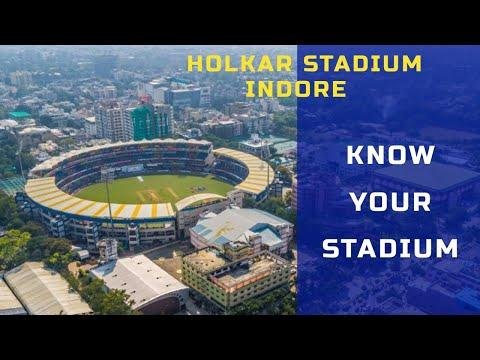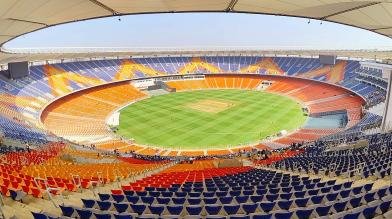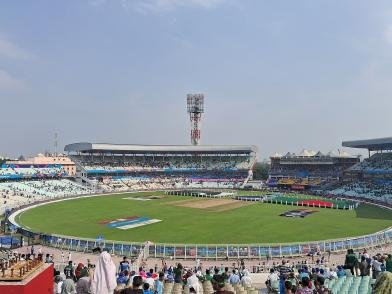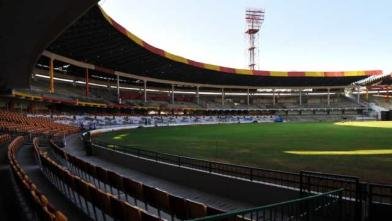❤️ The heart of Indore
The Holkar Cricket Stadium is a vibrant hub of cricketing passion, blending modern facilities with the rich legacy of the Holkar dynasty. Set against the bustling backdrop of Madhya Pradesh’s commercial capital, this stadium, formerly known as Maharani Usharaje Trust Cricket Ground, is a beacon for fans craving high-scoring IPL thrillers, intense Test matches, or electrifying ODIs. With its batting-friendly pitch, compact design, and electric atmosphere, Holkar Stadium is more than a venue—it’s a celebration of cricket’s enduring spirit in India. Dive into its storied history, unique features, and unforgettable moments below.
History of the Stadium
Holkar Cricket Stadium was established in 1982 and renamed in 2010 to honor the Holkar dynasty, which ruled Indore under the Maratha Empire. Construction began in 1997 under the Madhya Pradesh Cricket Association (MPCA), overcoming financial hurdles to create a modern cricketing venue. The south pavilion was completed first, followed by east and west stands, with the stadium fully operational by 2001. A landmark moment occurred in 1946 during a Ranji Trophy match, where Holkar’s batsmen set a world record with six centuries in a single innings, amassing 912 runs against Mysore. The stadium hosted its first ODI in 2006 (India vs. England) and its inaugural Test in 2016 (India vs. New Zealand), establishing itself as a key venue for international and domestic cricket, including IPL matches for Kings XI Punjab in 2017.
Location and Accessibility
Located at Race Course Road, Indore, Madhya Pradesh, India (Coordinates: 22.7126° N, 75.8330° E), Holkar Stadium is centrally positioned, just 8 km from Devi Ahilya Bai Holkar Airport and 5 km from Indore Junction railway station. Fans can reach it in 15–20 minutes by prepaid taxis or auto-rickshaws from the airport (₹200–₹300) or railway station (₹100–₹150). Local buses from Sarwate (3.5 km) or Gangwal (5 km) bus stands offer budget-friendly options. Nearby landmarks like Rajwada Palace (3 km) and Khajrana Ganesh Mandir (4 km) make it easy to combine match visits with sightseeing. Clear signage and well-maintained roads ensure hassle-free access, though match-day traffic may require early planning.
Architecture and Design
Holkar Cricket Stadium boasts a seating capacity of approximately 30,000, with general, premium, and VIP sections designed for optimal viewing. Its compact, modern architecture, overseen by the MPCA, incorporates traditional Indore elements and lush green surroundings, creating a visually appealing setting. The field features short square boundaries (54–61 meters) and longer straight boundaries (68–69 meters), with a batting-friendly black soil pitch offering consistent bounce and pace, ideal for high-scoring games. Four high-intensity floodlight towers (1,200 lux) enable vibrant night matches, while the open design ensures natural ventilation and clear sightlines. The stadium’s drainage system allows quick recovery from rain, supporting uninterrupted play.
Famous Matches and Events
Holkar Stadium has hosted iconic cricketing moments across formats, including seven ODIs (2006–2023), three Tests (2016–2023), and four T20Is (2017–2024). Standout matches include Virender Sehwag’s 219 off 149 balls in a 2011 ODI against West Indies, where India posted their highest ODI total of 418/5. In 2017, Rohit Sharma’s blistering 118 off 43 balls in a T20I against Sri Lanka set the stage alight. The 2016 Test against New Zealand saw India’s dominant 3–0 series win, with Ravichandran Ashwin claiming 13 wickets. The stadium also hosted nine IPL matches, notably for Kings XI Punjab in 2017. While primarily a cricket venue, it occasionally hosts cultural events, adding to its versatility.
Facilities
The stadium offers modern amenities, including food and beverage stalls with local Indori snacks like poha and international options, though prices (e.g., ₹80–₹150 for meals) may vary. Parking accommodates 2,000 vehicles, with designated spaces for differently-abled fans, but early arrival is advised during major matches. Players benefit from state-of-the-art dressing rooms, practice nets, and a well-maintained outfield. Media facilities include a press box named after commentator Sushil Doshi, high-speed Wi-Fi, and broadcasting setups for live coverage on Star Sports and Disney+ Hotstar. Accessibility features like ramps and reserved seating ensure inclusivity for all spectators.
Unique Features
Holkar Stadium’s compact design and short boundaries create an electric atmosphere, especially during night matches under its powerful floodlights. Pavilions named after cricketing legends like C.K. Nayudu, Mushtaq Ali, Sunil Gavaskar, and Sachin Tendulkar pay homage to Indore’s cricketing heritage. Fan zones with interactive games, merchandise stalls, and giant LED screens amplify engagement, while the lush green outfield adds aesthetic charm. The stadium’s reputation as India’s “luckiest ground,” with the home team unbeaten in most formats until 2022, adds a unique mystique for fans.
Fan Experience
Holkar Stadium is a cauldron of cricketing fervor, with fans describing the atmosphere as “electrifying” during IPL and international matches. Social media posts on X highlight the roar of 30,000 spectators cheering for Sehwag’s double century or Rohit’s T20I fireworks. The lush outfield and clear sightlines earn praise, though some fans note parking challenges and long food queues during sold-out games. Families enjoy kid-friendly zones, while groups revel in the vibrant “Indori spirit.” A 2023 review on TripAdvisor called it “a compact gem with unmatched energy,” making it a must-visit for cricket lovers seeking unforgettable memories.








